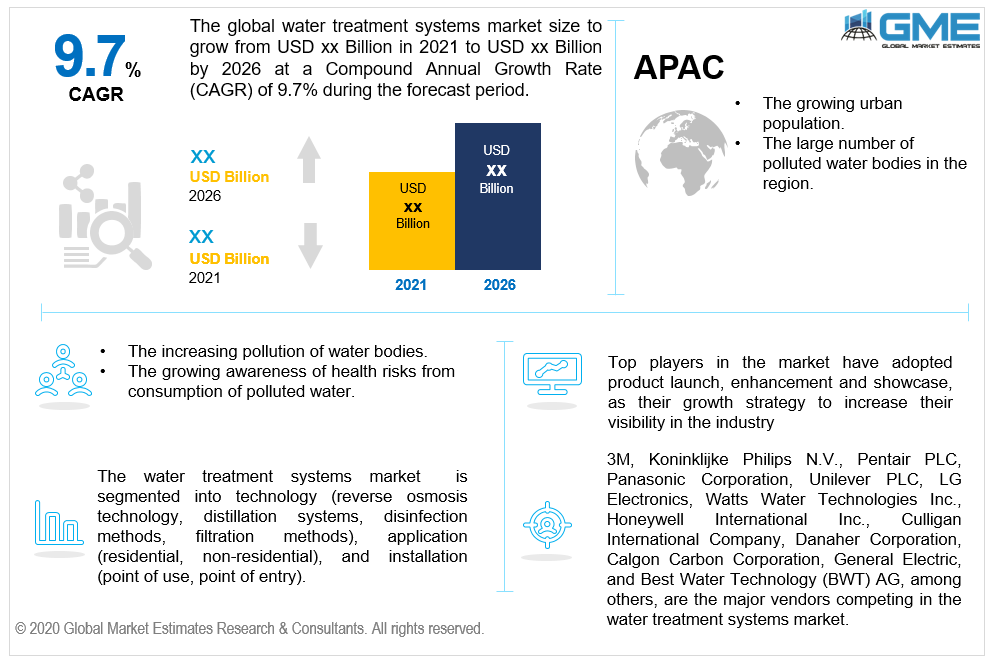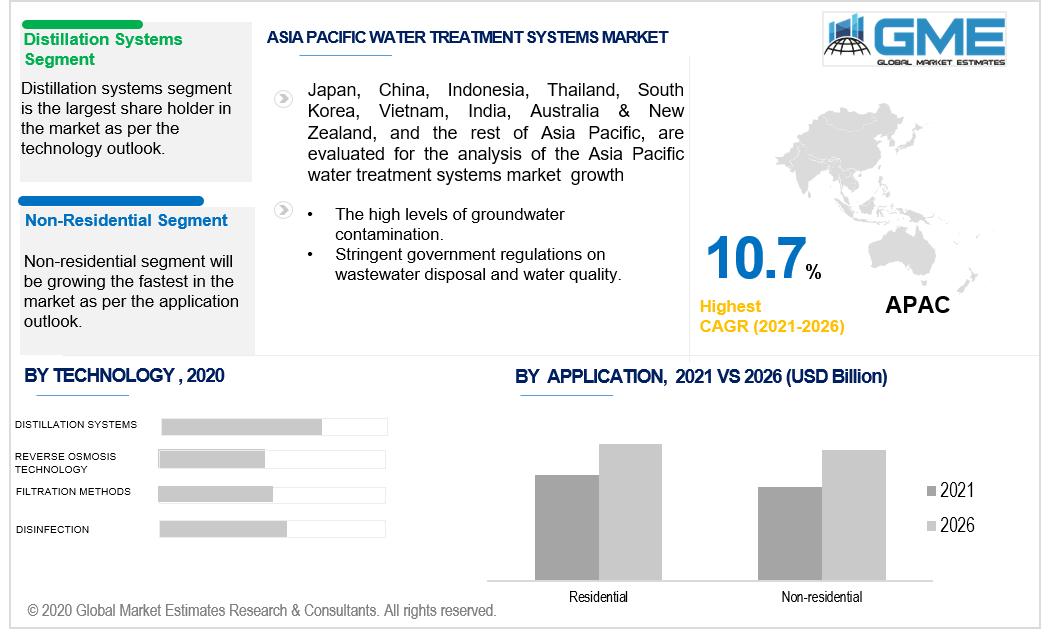
Global Water Treatment Systems Market Size, Trends, and Analysis - Forecasts To 2026 By Technology (Reverse Osmosis Technology, Distillation Systems, Disinfection Methods, Filtration Methods), By Application (Residential, Non-Residential), By Installation (Point of Use, Point of Entry), By Region (North America, Asia Pacific, CSA, Europe, and the Middle East and Africa); End-User Landscape, Company Market Share Analysis & Competitor Analysis
To purify polluted water bodies, water treatment facilities are used. One of the most essential compounds available to support life on Earth is clean drinking water. The growing population and contamination of water sources are major challenges in the 21st century. Even though more than seventy percent of the earth is covered in water, only less than one percent of it is drinkable as per international safety standards. Some of the major contributors to water pollution are wastewater from industrial and agricultural activities, municipal sewage and wastewater, and environmental changes. Even trace amounts of contaminants like heavy metals, dyes, and microorganisms are dangerous to the health of humans, aquatic life, and the environment as a whole. It's been difficult to get these toxic elements out of water bodies. Various techniques have been developed in recent years to combat water pollution, some of them are membrane filtration, reverse osmosis, flocculation, ion exchange, advanced oxidation processes, and biological methods. The demand for water treatment facilities has grown in response to rising levels of water contamination.
Portable water is growing in demand as the human population grows. The main sources of drinking water are rivers, streams, and other bodies of freshwater. As pollution levels are increasing, the number of polluted water bodies is also increasing. Industrial waste especially waste that has not been properly treated being dumped into water bodies is one of the major contributors to the growing water pollution levels. The dumping of chemical waste and debris from construction sites has left many rivers with high levels of contaminants. These contaminants have resulted in many water bodies being deemed as unfit for consumption without being treated. Water treatment systems have affordable prices that have enhanced the penetration of the market among consumers of varying financial capabilities.
The growing awareness of health risks from consuming contaminated water has also increased the demand for water treatment systems. Water can also act as carriers of various diseases like cholera and giardiasis. Waterborne diseases are a major health risk and are prevalent in developing nations that lack water security. Water treatment systems are capable of treating contaminated water and prevent the spread of such diseases. Governments all over the world are enacting rigid water management laws, which have raised the demand for such water treatment systems.

Based on the technology used in the water treatment system, the market can be segmented into reverse osmosis technology, distillation systems, disinfection methods, and filtration methods. The distillation systems segment is expected to hold the largest share of the market during the forecast period. The distillation technique is one of the oldest methods employed to purify water. In distillation systems, water is heated to its boiling point, the water vapors are collected, condensed, and cooled using a condenser and are then stored. The pollutants in the water are removed, leaving only healthier water behind. The water so obtained is not entirely pure and requires further treatment. The segment is driven by the relative ease of use, low-cost method, and widespread use of this technique. The disinfection methods segment is expected to register the fastest growth rate during the forecast period. Disinfection techniques use chlorination, ultraviolet treatment, ozone, and chloramines to disinfect water. Disinfection techniques are driven by the growing concerns of waterborne diseases and infections.
Based on the various applications of water treatment systems, the market can be segmented into residential and non-residential segments. The residential segment is expected to hold the dominant share of the market during the forecast period. The growing health concerns from drinking contaminated water are the major contributor to the large demand for water treatment systems in the residential segment. The growing urban population and the rising number of residential projects are other factors to the dominance of this segment.
During the projected era, the non-residential segment is anticipated to rise at the highest pace. Healthcare facilities, industrial units, educational facilities, and other such facilities are increasingly turning to water treatment systems to filter water and make it safe for consumption. This increased need for water treatment in various non-residential facilities is expected to increase the demand for water treatment systems.
Based on the point of installation of water treatment systems, the water treatment systems market can be segmented into point of use and point of entry segments. The point of use segment is expected to grow at the highest CAGR during the forecast period. Point of use water treatment systems is cheaper and more convenient to install.

The North American region is expected to hold the lion’s share of the market. The stringent government regulations in the region about water quality and water treatment are the major contributors to the high demand for water treatment systems in the region. The presence of multinational water treatment system vendors in the region is another factor for the market dominance. The APAC region is expected to register the fastest growth rate during the forecast period. The region is undergoing rapid urbanization which has increased the demand for safe water and water treatment systems. A large number of polluted water bodies in the region and high contamination of groundwater are also expected to increase the demand for water treatment systems in the region..
3M, Koninklijke Philips N.V., Pentair PLC, Watts Water Technologies Inc., Panasonic Corporation, EcoWater Systems, Unilever PLC, LG Electronics, A.O. Smith, Culligan International Company, Danaher Corporation, Calgon Carbon Corporation, General Electric, Honeywell International Inc., and Best Water Technology (BWT) AG, among others, are the major vendors competing in the water treatment systems market.
Please note: This is not an exhaustive list of companies profiled in the report.
In April 2021, Panasonic Corporation recently announced that Panasonic Energy (Wuxi) Co. Ltd. (PECW) has completed the first Zero CO2 factory in China, contributing to its list of carbon-free facilities
In February 2021, 3M planned to invest USD 1 billion within the next 20 years to drive new environmental objectives, including climate neutrality by 2050, a 25% reduction in water consumption at its facilities, and the return of higher-quality water to the environment following use in industrial activities.
We value your investment and offer free customization with every report to fulfil your exact research needs.
The Global Water Treatment Systems Market has been studied from the year 2019 till 2026. However, the CAGR provided in the report is from the year 2021 to 2026. The research methodology involved three stages: Desk research, Primary research, and Analysis & Output from the entire research process.

The desk research involved a robust background study which meant referring to paid and unpaid databases to understand the market dynamics; mapping contracts from press releases; identifying the key players in the market, studying their product portfolio, competition level, annual reports/SEC filings & investor presentations; and learning the demand and supply-side analysis for the Water Treatment Systems Market.

The primary research activity included telephonic conversations with more than 50 tier 1 industry consultants, distributors, and end-use product manufacturers.

Finally, based on the above thorough research process, an in-depth analysis was carried out considering the following aspects: market attractiveness, current & future market trends, market share analysis, SWOT analysis of the company and customer analytics.

Tailor made solutions just for you
80% of our clients seek made-to-order reports. How do you want us to tailor yours?
OUR CLIENTS